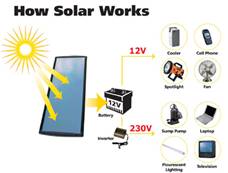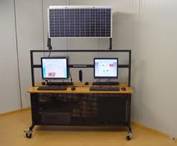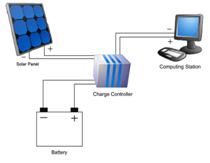 |
||||||
|
|
Home| Journals | Statistics Online Expert | About Us | Contact Us | |||||
 |
||||||
| About this Journal | Table of Contents | ||||||
|
|
[Abstract]
[PDF]
[HTML]
[Linked
References] Solar Computing: Use of Solar Energy to Run Computer System
Ayesha Anam Irshad Siddiqui Assistant Professor, Dept. of Computer Studies, Maulana Azad College of Arts, Commerce And Science, Aurangabad, Maharashtra, INDIA. Corresponding Address: Research Article
Abstract: In this paper an attempt is made to explain the technological changes that have made solar power cost feasible for PC (Personal Computer) deployments and provide an overview to design for a solar powered PC deployment. It is common belief that converting solar energy to electricity was firstly introduced over 130 years ago, and it has been used to power PCs for more than 20 years. Solar energy has an important, clean, cheap and abundantly available renewable energy. This technology has widest scope. India is one of the countries where solar energy can be replaced by electricity. Among the renewable energy sources solar photovoltaic (PV) energy has been widely utilized in small size applications with PC. The heat and light received from the sun support the environment on the earth and this shows significant role in utilizing of solar energy in deployment PCs. Keywords: Solar energy, solar cells, solar photovoltaic (PV) energy, Solar panel.
Introduction Solar energy is a solar power derived from the sun through the use of solar panels. Active solar energy involves the conversion of sunlight to electrical energy, especially in solar (photovoltaic) cells Solar energy is vital to support life on earth, it helps to grow our food, light our days, influence weather patterns, provide heat, and can be used to generate solar electricity. Solar electricity relies upon man-made devices such as solar panels or solar cells in order to provide a source of clean, and low cost renewable energy. Now-a-days solar energy technologies become more advanced; that are able to exploit the energy we receive from the sun to provide a greater, significant amount of electricity. Proper and uninterrupted supply of electricity is not feasible at various parts of world. Especially, countries like India have a big problem of electricity where a large amount of electricity is generated by traditional methods. Therefore, irregularity of rainfall makes severe this problem. But, countries like India have great scope for solar energy. The need today is to run computers in every corner of the country. Government, Banking, Financial Service and Insurance (BFSI), Education and Fast Moving Consumer Goods (FMCG), all sectors depend on ICT for effective execution. The power situation in India does not permit the use of computers in large parts of rural India.SPV based solar power generation has emerged as a reliable and efficient power source for those locations that are not connected to the electricity grid. A solar computing solution is feasible because of following reasons: 1. Run from the direct current generated by SPV and battery, not alternating current. 2. Light weighted, rugged and reliable, to reduce transport and service costs. 3. Able to operate in hot and dusty environments (like the climate of India) Due to limitations on time, space and financial budget generation of electricity does not remain feasible as:
Many researcher have been attracted towards development the better efficiency appliances that save electricity, at lower cost.
Figure 1: file photo showing working of solar energy. Solar Power can be used to supply electricity to homes, commercial settings and RVs. There are various types of Solar Power systems. In an RV, it would be ideal to use a stand-alone solar energy system. This type of system has lesser number of solar panels and batteries, making them economical. The function of the batteries is to collect solar energy during daytime. The system has an inverter that transforms the DC current into AC current that can be used by the appliances. Such generated energy can be used in heating home, water ,power pumps battery charging, cooking, indoor lightning etc. It is observed that there is significant role of solar energy in running a computer system. Uses of solar Energy
Use of Solar Energy to Run Computer system Running computer on solar power is an excellent way to work. Desktop computer can run on solar power. They are not as portables as a laptop but we get completely free electricity from the sun. Computers vary in the amount of power they need. A laptop computer uses much less power than a desktop, but in both cases it depends heavily on the types of hardware components in the computer and how it is used on a day to day basis. Here solar energy is replaced in place of electricity that decreases the consumption of electricity and moreover it is eco friendly too. Requirements for Solar Power Solar panel, Charge controller, Battery
Figure 2: file photo shows arrangement of computer systems based on solar energy
Working of computer with solar system
If charge controller has a male/female plug for connecting to the battery, we need an adapter that has the male/female combined plug on one end to connect to the controller, and the positive and negative wires on the other end to wire to the battery. Charge the battery from the solar panel for several hours to one full day before using it the first time. Connect inverter to the battery using the battery clips. Attach the positive (red) clip to the positive battery post and the negative (black) clip to the negative battery post. Turn on the inverter and plug computer cord into the outlet, and then turn the computer on.
Cost estimation for Solar Panel Installation The cost of power generated from coal and natural gas can range from Rs. 2 to 3 per KWh. The cost of wind power falls between Rs. 3 and 3.2 per KWh. In 2009, the cost of Solar Power from photovoltaic cells and solar thermal falls between Rs. 10 and Rs 15 per KWh. Solar photovoltaic systems sized between 1 to 5 kilowatts are usually sufficient. The average homeowner saves over Rs.50000 a year on electricity by installing solar panels on their roof. That's including the cost of solar panels. The most common way to go solar today is by leasing, which essentially means instead of paying the utility you pay less to produce your own energy. Electricity required for running computers:A typical desktop computer uses about 65 to 250 watts. LCD monitor use 15-70 watts. Most laptop computers use about 15-60 watts, far less than desktops. Total cost can be calculated as:
For example, A computer require 200watts. Energy consumption and cost evaluation: 200 watts x 24 hours x 365 days/yr = 1,752,000 watt-hours, or 1752 kilowatt-hours. If we are paying Rs.5 per kWh, so we are paying Rs. 8760 a year to run computer
Conclusion
References
|
|||||
|
||||||


